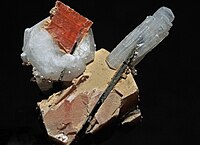
Photo from wikipedia
Abstract The Taipingzhen deposit is a newly discovered REE deposit in the North Qinling Orogen (NQO), Central China. The REE ores are hosted in the altered fracture zones of Paleozoic… Click to show full abstract
Abstract The Taipingzhen deposit is a newly discovered REE deposit in the North Qinling Orogen (NQO), Central China. The REE ores are hosted in the altered fracture zones of Paleozoic strata and a granitic intrusion. The ore minerals mainly include bastnasite-(Ce)[(Ce(CO3)F], parisite-(Ce)[CaCe2(CO3)3F2], and synchysite-(Ce)[CaCe(CO3)2F], and this deposit also contains some uncommon minerals, such as tornebohmite-(Ce)[Ce2Al(SiO4)2(OH)], gatelite-(Ce) [CaCe3AlAl2Mg(Si2O7)(SiO4)3O(OH)2], fluocerite-(La)[LaF3] and F-rich cerite-(Ce)[(Ce,Ca)9 Mg(SiO4)3[SiO3(OH)]4F3], which are identified here for the first time in China. To determine the timing of REE mineralization and explore possible genetic relationships between mineralization and granitic magmatism, the U-Pb ages of bastnasite-(Ce) from ore and zircon from ore-hosting granite are obtained. The in situ LA-MC-ICP-MS U-Pb age of the bastnasite-(Ce) provides a reliable 238U/206Pb-207Pb/206Pb lower intersection point age of 409 ± 16 Ma, and ID-TIMS analyses yield an U-Pb age of 407.8 ± 3.3 Ma; the U-Pb dating of the magmatic zircon reveals that the wall rock was emplaced at 457.1 ± 4.9 Ma, and the hydrothermal zircon age of 399.4 ± 3.5 Ma records the time of hydrothermal alteration, thus indicating that the REE mineralization in the Taipingzhen deposit occurred at approximately 409–400 Ma. This age coincides well with the U-Pb ages of the bastnasite-(Ce) and zircon, revealing a genetic association between the hydrothermal fluid and the REE mineralization. The Hf isotopic compositions imply that the partial melting of Paleoproterozoic HP and UHP eclogite from the lower crust provided ore materials for the mineralization, and the deposit was generated in a retrograde metamorphic setting during the late Paleozoic postcollisional extension event in the NQO. Furthermore, combined with the geochronological data published for other U-REE metallic deposits in the NQO, our study indicates that the late Silurian-early Devonian granite-related U-REE metallic mineralization throughout the NQO mainly occurred during 421–395 Ma.
Journal Title: Journal of Asian Earth Sciences
Year Published: 2019
Link to full text (if available)
Share on Social Media: Sign Up to like & get
recommendations!